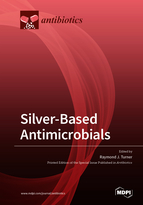Silver-Based Antimicrobials
A special issue of Antibiotics (ISSN 2079-6382).
Deadline for manuscript submissions: closed (30 June 2018) | Viewed by 109815
Special Issue Editor
Interests: metal based antimicrobials; resistance mechanisms; biofilms; antimicrobial properties; bioremediation; metal nanomaterials
Special Issues, Collections and Topics in MDPI journals
Special Issue Information
Dear Colleagues,
Long before the discovery of antibiotics, silver had been used to help keep water fresh on ships of passage, and alchemists used it to treat wounds to improve healing and to heal contagious diseases, which led silver (and other metals) to acquire a reputation of having antimicrobial properties. However, with the introduction of antibiotics, the use of silver as an antibacterial agent drastically decreased. Driven by the great challenges that the increased prevalence of drug-resistant pathogens have posed as we move into the antibiotic resistance era, the interest in employing silver to combat bacterial infections has recently been revived. Research to date suggests that silver has superior antibacterial efficacy over other medicinally relevant metals.
In this Special Issue of “Silver-Based Antimicrobials”, we will highlight research findings that cover topics centering on silver as antibiotic, antiseptic, and surface coating for infection control. It will involve but be not limited to:
- mechanism(s) of resistance
- mechanism(s) of toxicity
- mechanisms of action
- delivery vehicles
- specificity
- cytotoxicity
- hemolytic activity
- binding of silver to biomolecules
- synergies with other antimicrobials
- novel formulations
- nanoparticles
- novel coatings
- agriculture and animal use
- waste issues
Despite its well-known antimicrobial properties, silver’s mechanisms of action—whose diversity contributes to the rarely reported resistance—have not been completely elucidated. Additionally, surprisingly little is known of its toxicology to humans and other animals. Therefore, we are also particularly interested in discoveries of its mechanisms of action in this Special Issue.
Prof. Dr. Raymond J. Turner
Guest Editor
Manuscript Submission Information
Manuscripts should be submitted online at www.mdpi.com by registering and logging in to this website. Once you are registered, click here to go to the submission form. Manuscripts can be submitted until the deadline. All submissions that pass pre-check are peer-reviewed. Accepted papers will be published continuously in the journal (as soon as accepted) and will be listed together on the special issue website. Research articles, review articles as well as short communications are invited. For planned papers, a title and short abstract (about 100 words) can be sent to the Editorial Office for announcement on this website.
Submitted manuscripts should not have been published previously, nor be under consideration for publication elsewhere (except conference proceedings papers). All manuscripts are thoroughly refereed through a single-blind peer-review process. A guide for authors and other relevant information for submission of manuscripts is available on the Instructions for Authors page. Antibiotics is an international peer-reviewed open access monthly journal published by MDPI.
Please visit the Instructions for Authors page before submitting a manuscript. The Article Processing Charge (APC) for publication in this open access journal is 2900 CHF (Swiss Francs). Submitted papers should be well formatted and use good English. Authors may use MDPI's English editing service prior to publication or during author revisions.







